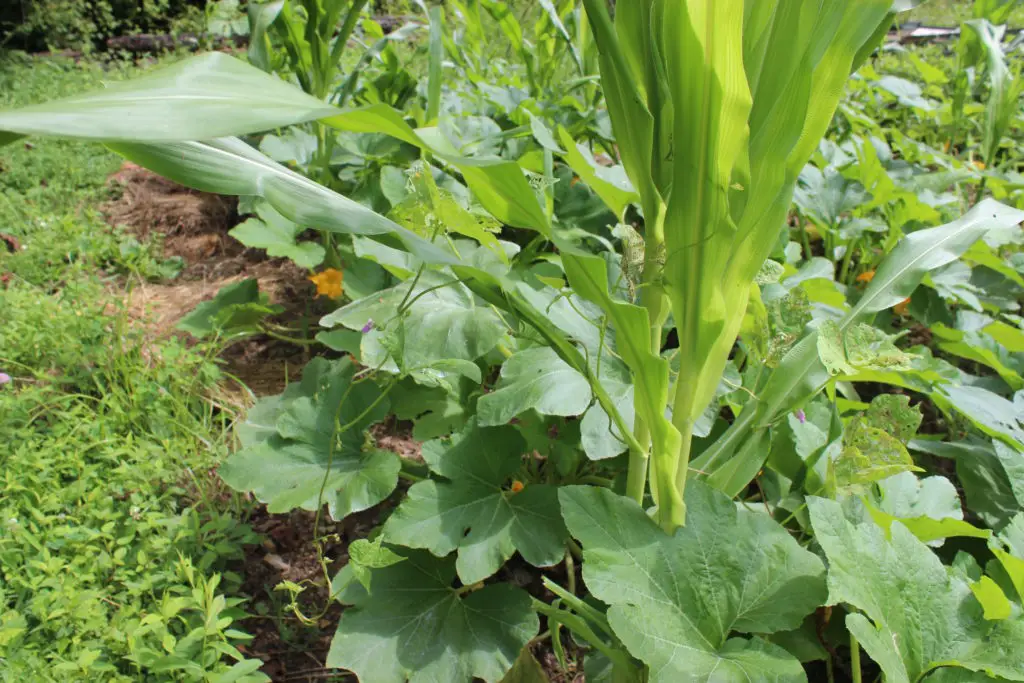We’re used to seeing field after field of nothing but corn in my town. But sweet corn grows just as well in the backyard garden as it does in agricultural fields. You can enhance the growth of your sweet corn if you companion plant. However, there are 11 plants you should never plant with corn and 12 that you should!
In this article, we’ll talk about the 11 plants you should never plant with sweet corn. We’ll also talk about plants that help your sweet corn grow even better! But first, let’s take a look at what companion planting is and how to use it.
What Is Companion Planting?
Companion planting is growing different plants together so that they help each other grow. For example, companion planting may help to attract pollinators and other beneficial insects. It can deter pests. It can encourage soil nutrients.
Companion planting is a centuries-old practice that we can see in the three sisters garden (which I wrote about in detail in this article), where beans and squash are grown together with corn to create the perfect balance.
Learn how to raise your own quail and have an unlimited supply of eggs and meat.

The corn creates a trellis for the beans. The beans stabilize the corn and fix the soil, while the squash shades the ground to keep down moisture and weeds. As a result, the three plants grow even better together than they do separately.
Companion planting isn’t always an exact science, however. It takes a lot of trial and error to figure out which pairings work best for you. And when it comes to corn, there are specific plant pairings you should always avoid.
In a small garden, you might not have a lot of room to separate your plants. You may end up needed to pick and choose which plants are most important to grow and which plants you may want to leave out altogether.

11 Plants to Never Plant with Corn
Tomatoes
There are a couple of reasons not to plant corn and tomatoes together. First, tomatoes are heavy feeders, just like corn. They need lots and lots of nutrients. So growing them together could mean that the two types of plants are competing for the same nutrients. So there just won’t be enough soil nutrition to go around.
On the other hand, both tomatoes and corn are affected by the same types of pests. For example, the tomato fruit worm affects both tomatoes and corn. It is also known as the corn earthworm or tomato hornworm. If your tomatoes and corn are planted near each other, the infestation could multiply and take out both of your crops. Therefore, it’s better not to plant tomatoes and corn together.
Egg Plant
Eggplants and corn won’t do any actual harm to each other, but that doesn’t mean they like sharing the same space. To be honest, both corn and eggplants are heavy feeders, so they’ll compete for nutrients in the soil. So keep them separated for better growth.
Cabbage
Cabbage loves the full sun and lots of nutrients in the soil. If you plant it next to corn, it will have to compete for nutrients in the soil. Both plants may end up with poor growth if there aren’t enough nutrients to go around.
On the other hand, cabbage won’t grow well if the corn shades it out, so keep it away from corn.
Broccoli and Cauliflower
Broccoli – as well as other cruciferous veggies, like cauliflower, aren’t good choices to plant near corn. They need too much sun and too many soil nutrients to make them good neighbors for your corn plants.
Kale
Kale is another plant that just doesn’t play well with corn. It probably wouldn’t hurt the corn, but corn can easily shade out this sun-worshipper. Kale is also a heavy feeder and will force the corn into competition for soil nutrients.
Kohlrabi
You don’t want kohlrabi near your corn, either, for the same reasons. It needs too much sun and too many nutrients in the soil for it to be companion planted next to corn.
Brussel Sprouts
Brussel sprouts are also heavy feeders. They need lots of space so they can have enough soil nutrients to grow, so keep them away from corn, or your corn and Brussel sprouts might not grow well.
Garlic
Garlic might not hurt corn but keep the garlic away if you are companion planting beans with your corn. Garlic inhibits the growth of beans and peas, so don’t companion plant it with your corn and beans.
Celery
Celery is a heavy feeder and needs lots and lots of water to grow. But so does corn, so if you plant them together, they’ll compete for both water and nutrients. So your celery and your corn could end up with stunted growth if you try to grow them together.
Fennel
They say fennel is only friends with itself. But, unfortunately, fennel just doesn’t grow very well with any other vegetable or garden plants. It can kill or stunt the growth of almost any other vegetable, so you’re best off just avoiding planting fennel at all.
12 Plants to Plant with Corn
Although there are plants, you should avoid planting with corn. However, there are some that make excellent garden mates for your sweet corn patch.
Pole Beans
Pole beans are a part of the three sisters garden method. Corn can provide a trellis for pole beans, and the pole beans will improve the soil and help stabilize the corn against strong winds. It’s a win-win!
Squash
Almost any variety of squash makes a great companion plant for corn. Squash will spread out and shade the soil, keeping down weeds and retaining moisture. This saves you time and water!
Marigolds
Marigolds are pest repellent. Plant them around the outside of your corn patch to keep the pests away. They also look pretty and will attract pollinators to your garden area.
Amaranth
Amaranth is a great plant to grow in between smaller corn patches. It will act as a living mulch to squash weeds and retain moisture in the soil.
Melons
Melons are similar to squash. These vining plants will shade the ground, keeping away weeds and retaining moisture.
Borage
Borage is a great choice to plant near corn because it will attract pollinators to your garden. It will also deter and distracts pests from eating your corn.
Mint
Mint is so aromatic that it tends to deter deer, which love to munch on your corn patch.
Nasturtiums
These flowers are both pretty and edible! Better yet, plant them a short distance away from your corn to attract aphids away from your corn crop and towards the nasturtiums.
Thyme
Thyme is another aromatic herb. Its delightful scent will repel earworms, which are a common pest in corn patches.
Cucumber
Cucumber can act as a living mulch, just like squash and melons. This vining plant will grow along the ground, shading the dirt. It will help prevent weeds and keep moisture in the soil.
Dill
Dill attracts beneficial insects like parasitic wasps that will control pests that will damage your corn crop.
Horehound
Horehound will deter pests from your corn and other vegetable plants, and makes a good companion for corn.
Rosemary
Rosemary is an aromatic herb that will also deter pests and thus helps your corn thrive.
Plant Hedgerows Around Your Corn Plot
Hedgerows are living fences that you can plant around your garden or your corn crops. Hedgerows serve a variety of purposes.
First, they increase the number of pollinators and beneficial insects in the area while distracting destructive insects away from your corn.
Hedgerows also offer protection from the wind, which will keep your corn from falling over. These living fences can be planted thick enough to prevent animals from getting to your corn patch, and they can also be used to conserve water.
A hedgerow should be staggered in height and consist of a variety of different native plants. Here are some ideas of lants that you can put in your hedgerow around or near your corn.
- Geranium
- Goldenrod
- Sunflowers
- Sweet alyssum
- Yarrow
- Black-eye Susans
- Buckwheat
- Lacy phacelia
Rules of Thumb to Keep in Mind for Corn Companions
Corn is easy to grow in your home garden. However, it needs rich, fertile soil and lots of water. When in doubt, never plant corn with other vegetables that need lots of sunlight, lots of water, or lots of nutrients. Doing so will cause the corn to compete with the other plants, and you may end up with a poor crop of everything.
Sun-loving brassicas won’t grow in the shade of corn, so plant them far enough away to get full sun.
Avoid planting corn with vegetables that have similar pests. For example, if your tomatoes get infected, and they are growing too near to your corn, the pests will move right from the tomatoes and directly to your corn. Keep them separate so that if your tomatoes get worms, they won’t crossover onto your corn stalks.
On the other hand, it’s good to plant corn with other vegetables that shade the ground, such as melons, cucumbers, and squash. Because these plants spread out, their leaves can shelter the ground to reduce moisture evaporation and keep weeds down.
You can also plant corn with legumes because they add nitrogen to the soil.
Surround your corn with pest repelling plants such as mint, thyme, or marigolds to keep your corn happy and healthy.
Happy planting!
